It is our pleasure to welcome RL Poole, author of The Leedskalnin Codex: Breakthroughs In Understanding The Coral Castle, as our featured author for March.
For almost a decade RL Poole has investigated the mysterious construction of Coral Castle and the man who built it singlehandedly, using only simple tools and claiming he ‘knew the secrets of the Great Pyramids’. In his book RL Poole takes us on fascinating and unique journey of discovery, decoding the riddles and teachings of this modern megalith and the man responsible for it, Edward Leedskalnin.
‘By the time the castle was complete, Leedskalnin—who stood all of five feet tall, who weighed no more than a hundred and twenty-five pounds—had quarried 1,110 tons of huge, brittle blocks of oolitic limestone, commonly known as coral rock. He had moved them, carved them, and set them in place with a precision rivalling that of the Great Pyramids of Egypt—whose blocks weigh[ed] only half as much of those he had quarried…
How did he do it?
Back in the day, when people asked, Ed usually would give a sly smile and say that he “knew the secrets of the Great Pyramids.”‘
-From Coral Castle: The Mystery of Ed Leedskalnin and His American Stonehenge, by Rusty McClure and Jack Heffron (2009).
A bit about RL
RL Poole is an independent researcher, author and speaker who has spent the past decade and a half scrutinising the cryptic written work and mysterious monument left to us by the late Edward Leedskalnin. The Leedskalnin Codex: Breakthroughs In Our Understanding of the Coral Castle is at once the culmination of these years of work, and the beginning of a line of thought that takes the scientific ideas and teachings of Leedskalnin seriously.
Poole is a high-functioning autistic person with an intellectual range in the ‘Very Superior’ category (Weschler III, 2005). He’s member of American Mensa, an organisation whose only requirement for membership is to have an Intelligence Quotient (IQ) in the top 2% of the population. In standardised scholastic testing, Poole was ranked in the 99th percentile and pronounced ‘untestable’ in his highest scoring areas: deductive reasoning, memorisation, pattern recognition, and communication. In other words, the test couldn’t find limitations in these categories.
These are the natural tools with which Poole decrypts and translates the brilliance of Leedskalnin’s ideas.
A bit about Ed
Born in Latvia on January 12 1887, Edward (Ed) Leedskalnin was a self-taught engineer who single-handedly built the Coral Castle in Homestead, Florida, after emigrating to the USA in 1912. We know little about his childhood, apart from that his parents weren’t wealthy, and that he was only formally educated until the age of nine or ten. It’s suggested that Ed loved reading, and that he learned stonemasonry skills from his father. We know that by the time Ed was in his twenties, he could read, write and probably speak at least three languages.
At the age of 26, Ed was engaged to marry. The name and age of his fiancé is up for debate, for while Ed himself said he was jilted at the altar by his ‘Sweet Sixteen’—16-year-old Agnes Skuvst—Latvian historians have on record a different name and age for her—Hermīne Lūse, who wasn’t sixteen, but just two years younger than Ed.i Ed’s main motivation for moving to the US was reportedly heartbreak, though extreme political unrest in Latvia will have served as motivation—some have said he left because of fear or retribution by the Tsar’s police.ii
Between Ed’s arrivals in New York in 1912 and in Florida City in 1923, he moved often, spending time living in the Pacific Northwest and in Washington, among other places. At some point during the winter of 1922-1923, an estate agent called Ruben Moser found Ed lying in a heap on the side of the road. Moser helped Ed into the car and drove him home. Ed was seriously ill with a respiratory disease and was on the verge of dying. It has been suggested by eyewitness statements that Ed had been wandering around with a ‘witching rod’, capable of determining the presence of water or ‘energy’ in the earth. One eyewitness claimed that when asked what the rod was for, Ed just said, ‘when I find it, I’ll know it.’iii
Moser and his wife fixed a room in their tool shed for Ed and nursed him until he recovered.
It’s believed Ed had tuberculosis, which wasn’t curable in 1923, so his full recovery is usually described as a miracle. Some speculate that Ed cured himself using his unique knowledge of electromagnetism and ultraviolet rays from the sun.
By the end of winter 1922, Ed bought a section of land from Moser upon which he single-handedly built Rock Gate, also known as the Coral Castle. Then, in 1937, with barely any help, Ed moved his Coral Castle to a new location in Homestead, Florida. Ed died from a kidney infection in December 1951.
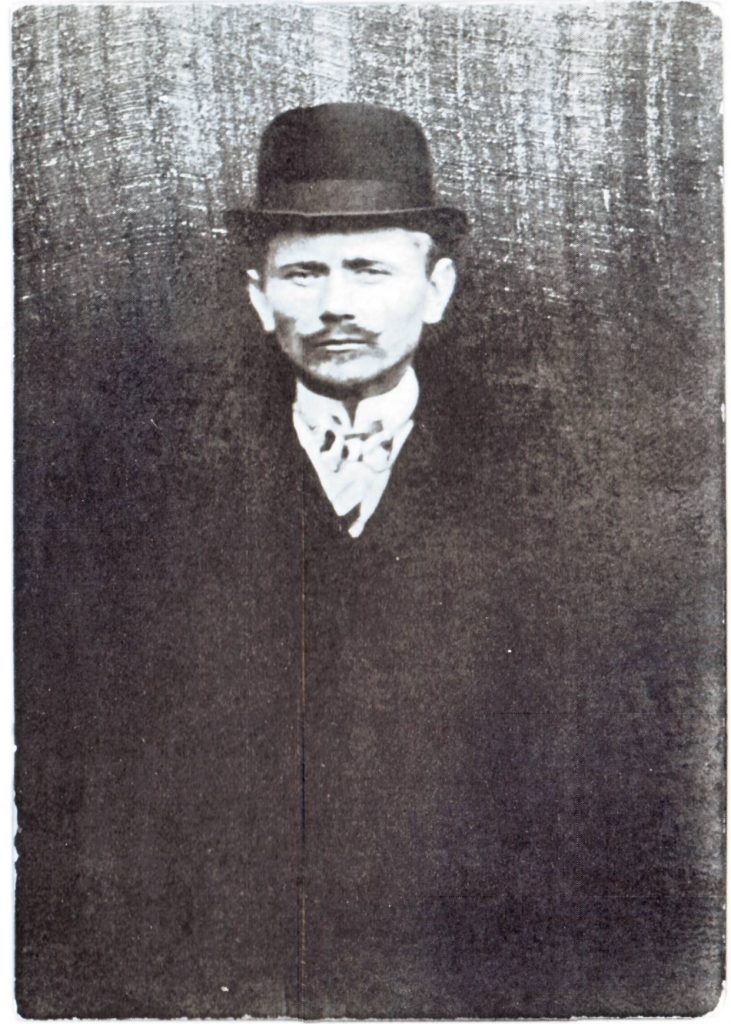
Edward Leedskalnin in Latvia, circa 1910. Collection of Latvia’s historical images by Māris Goldmanis, Researcher at University of Latvia.
The wild evidence chase
As recently as June 1st 2018, in a Live Science article entitled, ‘Mystery of the Coral Castle Explained,’ the ironically entitled ‘Bad Science columnist’ Benjamin Radford takes a shallow approach to the methods and means by which Leedskalnin could have built the Coral Castle:
‘As tempting as it is to view the amazing park through a veil of mystery, in fact we know how the castle was built. Creating a structure like the Coral Castle today could probably be accomplished in a few months with a construction crew and modern machinery. But Leedskalnin worked alone using basic tools like picks, winches, ropes and pulleys. Leedskalnin himself said that he did it using hard work and the principles of leverage.’iv
First, we must acknowledge the fact that those who claim to know how the Coral Castle was built simply can’t believe that we don’t know how Leedskalnin did it. It’s a mystery and some people like Benjamin Radford just don’t critically engage with mysteries.
What does Radford mean by his claim that Ed built the castle using ‘hard work’ and ‘the principles of leverage’? In addition to the limited information provided by the Coral Castle museum about Ed’s tools, Radford cites a single source to defend his stance—the account of Orval Irwin, who ‘explains, through photographs, drawings, and schematics, how it was done’.v
It’s true that Irwin gives a detailed account of how he helped Leedskalnin haul the boulders and tools to the Coral Castle’s new home in Homestead, Florida in 1937, but Irwin wasn’t present during Ed’s construction of the castle – nor was anyone. It has been firmly established by multiple eyewitness statements that Ed built the castle entirely on his own, at night, so no-one could watch him. And those who knew Ed have claimed that he deliberately misled them, hid the secrets he possessed, and offered explanations that didn’t tell the whole story.
It is indeed widely accepted that Ed ‘quarried by hand from pits nearby, using only rock ax, crowbar, sledges and an ingenious arrangement of levers.’vi But the question that Radford and other sceptics fail to address is how Ed moved the giant stones and set them into place so they stand tightly, side by side, with tops so even you’d expect they had been shaped by a machine.
In his account of his time assisting Ed, Mr Can’t Is Dead, Irwin indeed, as Radford reminds us, states:
‘…His was a generation who knew accomplishments by the sweat of the brow. It wasn’t mysticism but hard work, this is how Ed really accomplished the massive project.’vii
Sweat of the brow and hard work indeed, but Irwin and Radford fail to prove their point.
The practical mathematics of the lifting and setting in place of the heaviest 30-ton boulder—the North Wall of the Coral Castle—must be described in detail here. To lift this momentous boulder using simple Archimidean leverage as Radford and Irwin suggest, Leedskalnin would have needed a lever 148 feet in length, with 22,222.22 lbs on its working end. The working end would have needed to be 40 feet in the air at the start to raise the stone to equilibrium at 10 feet. To move the block 10 feet up to equilibrium on the fulcrum, he would have needed to hang the equivalent of 11 full-sized family vehicles 40 feet in the air on a lever just 148 feet long. This is simple maths, which can be deduced on any engineering calculator.
So, Radford’s suggestion that Leedskalnin lifted and set this 30-ton boulder alone using basic tools and ‘the principles of leverage’ is unverifiable. How could 5ft tall, 100-pound Ed have withstood a combined weight of over 82,000 lbs? And who among us could single handedly drive the wedges into the ground to the depths shown on the walls of the Coral Castle?
Let’s take a look at the perspective of the most recent and thorough research on the Coral Castle by New York Times bestselling author Rusty McClure and Jack Heffron, ‘the first book to take an objective, journalistic look at the Coral Castle’:
‘The gates, more than any other aspect of the castle, cast doubt on the theory of Ed’s using only engineering skills and simple tools. How could he have balanced those gates so precisely while the chain-wrapped stone was suspended from a block and tackle? He may have been skilled enough to quarry such huge stones with simple tools, but it’s tough to imagine him using those tools to move the rocks into place so exactly that there is barely a seam between them. And to then balance the rocks so that they swing with the slightest touch?
…When reading about the size and weight of the stones, it’s difficult to believe one man—even a talented engineer—could do it alone. Standing next to them, it’s nearly impossible.’viii
An ‘objective… look at the Coral Castle’, yes. But ‘nearly impossible’ to believe that one man could do it alone? Impossible, surely – at least it would be impossible to replicate these feats of engineering using the tools Ed used, or by using modern machinery. In 1986, a crew of six men and a twenty-ton crane failed to repair the 9-ton gate of the castle back to the perfect condition with which Ed built it, alone, without the help of five others, and without the use of machinery. And the gate hasn’t spun as easily as it did in Ed’s time—engineers today are still puzzled as to how he delicately poised the great swing door on its centre of gravity so it opened at the touch of a finger. To this day, his lone engineering skills haven’t been matched by anyone, let alone beaten.ix
So how could he have done it?
That Ed constructed the castle with such startling precision that the boulders slot into place with ‘barely a seam between them’ gives a clue. So does his claim – that he ‘discovered the secrets of the pyramids’ and ‘found out how the Egyptians and the ancient builders in Peru, Yucatan and Asia, with only primitive tools, raised and set in stone blocks of stone weighing many tons.’x
We know that Ed was so preoccupied by astronomy that he built astronomical features into his castle. We also know that Ed was preoccupied by the principles of electromagnetism, for he published complex, cryptic, books on magnetism and astrophysics.
Not only this, for in 1937 Leedskalnin moved his castle to a site in Florida that is located on an intersection of the Earth’s energy grid, or ley lines, and many people believe that where ley lines intersect, there is tremendous electro-magnetic power. It’s thought that Stonehenge in the south of England and the Giza plateau in Egypt, along with a wealth of other ancient megalithic sites, are located at intersections of this energy grid.xi
Megaliths, electromagnetism, astronomy, and cryptic scripts. Anyone care to guess where we’re going with this?
Cutting to the chase
McClure and Heffron’s book is thorough in its covering of Edward Leedskalnin’s life history and the possible methods and means by which he built the Coral Castle. They cover Ed’s life history by use of the limited secondary sources left to us in the form of eyewitness accounts after his passing in 1951, and their book gives us much food for thought.
An important portion of this food for thought is their brief covering of Magnetic Current, the book Ed published in 1946 after moving the Coral Castle to its new location:
‘In the booklet, Ed blasts scholars and scientists, calling them “the men with the long hair.” He dismisses prevailing theories of physics and most other natural sciences, from botany to biology. His theories replace the atom—specifically electrons—with magnets. He writes that the magnetic north and south poles “are the building blocks of nature’s perpetual transformation of matter and they are so small they can pass through everything.” This allowed him to redefine both the law of gravity and the nature of electricity. He saw the former as a force created by magnetic energy concentrated at the Earth’s core. The pull of that magnetic force on the magnets that fill everything accounts for what we know as gravity.
…One would think such a claim would send scientists from throughout the world scurrying to Ed’s door, but he seems to have been mostly ignored.’xii
Having spent the best part of a decade scrutinising Magnetic Current and Ed’s other booklet, Mineral, Vegetable, and Animal Life, I can safely say that Coral Castle theorists have missed the mark on this one. What better information do we have at our disposal in understanding this mysterious accomplishment than the writing and monument that Leedskalnin himself left behind? McClure and Heffron explain why Ed’s work, the intuitive starting point in our unravelling of this fascinating riddle, has been neglected by most Coral Castle theorists:
‘Mainstream scientists scoff at Ed’s work, which has never been accepted as legitimate. Some see this as at least partially due to his inability to articulate his thoughts; lacking a background in physics and mathematics, he was unable to express in a meaningful way the discoveries he made in his experiments.’xiii
Sometimes the ingenuity of things we don’t understand can be hidden in plain sight, and a change of perspective from the information spoon-fed to us by our education systems is what’s needed. Take, for example, the breakthrough of ‘rogue archaeologist’ John Anthony West in the early nineties, whose reinterpretation of ancient Egyptian hieroglyphics based on his rediscovery of Schwaller de Lubicz’s nineteenth century writings ‘cracked the code’ in our understanding of not only ancient Egypt, but arguably of ancient world history.
So, when McClure and Heffron explain that Leedskalnin’s books were overlooked due to his failing to ‘express in a meaningful way the discoveries he made in his experiments’, perhaps what those thinkers needed to do was leave behind their preconceived notions and give his writing a chance to offer clues in our cracking of the Coral Castle code.
This leaving behind of preconceived ideas is what I’ve spent the best part of a decade doing, to do the mystery and ingenuity of Edward Leedskalnin justice. I realised that if I were to be successful in my work, I had to decide that everything I had ever learned or been told about the Coral Castle was wrong. With a blank slate, on the basis of zero assumptions, and using the tools of observation, deductive reasoning and the instructions that Ed gives in his books, I set about my task.
The Secret Schematic and the Perpetual Motion Holder
In the winter of 2010, I discovered that by overlapping the covers of Edward Leedskalnin’s Magnetic Current and Mineral, Vegetable and Animal Life, the symbols intersect and create a diagram. I then discovered that once the diagram on Magnetic Current is added to that on Mineral, Vegetable and Animal Life, the close-looped magnetic device featured on Mineral, Vegetable and Animal Life is transformed into an open circuit electrical device.
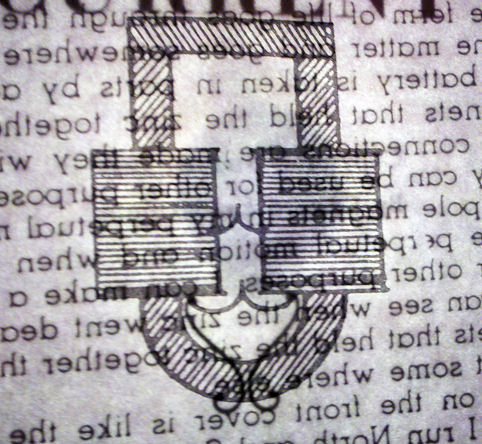
Photo of overlapped covers showing a hidden diagram separated on the covers of two of Ed Leedskalnin’s written works. Placing one cover over the other shows the complete schematic. Discovered by RL Poole in December of 2010.
The patience of studying without professing a theory garnered the results necessary to keep discovery alive. I refused the intellectual temptation to begin speculating immediately upon the discovery of a single clue. Better instincts prevailed, and I was able to focus on the more exciting thought: Leedskalnin left clues behind, so how many could I find and decode?
Once I started finding and decoding these clues, I had to ask myself, where is this all going? What is the endgame, and what secret is Ed trying to tell us from the beyond? This was the first breadcrumb on the trail, and finding the trail itself, for me, was the discovery.
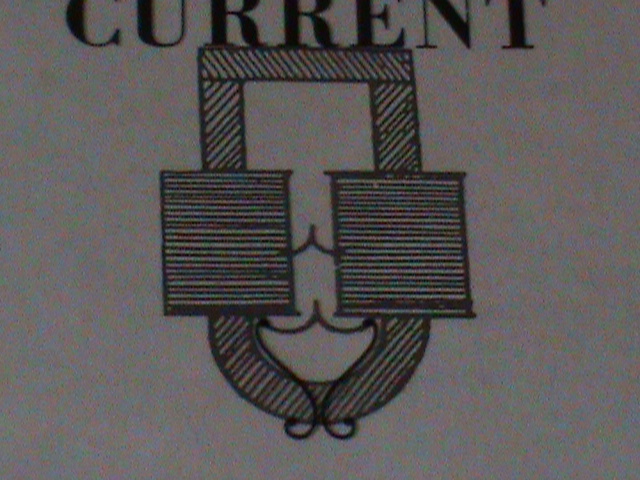
Overlapping the covers of Ed Leedskalnin’s written works Magnetic Current and, Animal, Vegetable, and Mineral Life, reveals a hidden diagram for Ed Leedskalnin’s Perpetual Motion Holder. Hidden by Ed Leedskalnin in August of 1945 and discovered by RL Poole in December of 2010.
Ed Leedskalnin was a most cryptic soul, once you get to know his methods. I laugh to myself sometimes when I think about Ed’s brainteasing style of knowledge sharing. If Ed and I had somehow met and become friends, I would have introduced him to comic books. I think he would have been a big fan of another Edward with the same penchant for encoding data in clever ways: Edward Nygma, ‘The Riddler’ from the Batman comic series.
The first sentence in Ed’s book, Magnetic Current, is one of the oddest and most confusing lines I’ve ever read:
‘This writing is lined up so that when you read it, you are facing East, and everything you read about magnetic current, it will be just as good for your electricity.’
That makes absolutely no sense unless we’ve found the secret schematic hidden on the two covers of the booklets—when we attach the leads shown in the schematic to the Perpetual Motion Holder (PMH), we turn the PMH from a magnetic device into an electrical device.
‘…and everything you read about magnetic current, it will be just as good for your electricity.’

Leedskalnin says, “This writing is lined up so when you read it you are facing East.” Once you understand it, the rest becomes clear.
What happens when we face east? And this is the clever bit. When we’re facing east, north is on our left, and south is on our right. He’s telling us the polarity of the magnetism of this electrical device—and that we’ve understood his teachings so far.
If left is magnetic north, then by Ed’s explanation it is positive (+) electrically. In the same vein, south is negative (-) electrically. These words only make sense when we know what Ed is talking about. This was one of Ed’s favourite things—hiding information so subtle we can barely perceive it, and when we finally see it, it becomes impossible to see it any other way.
This is the greatest teaching method I have ever experienced. Ed doesn’t tell us the answer, but encourages us to discover it ourselves, with the promise that it is there to be found if we look for it.
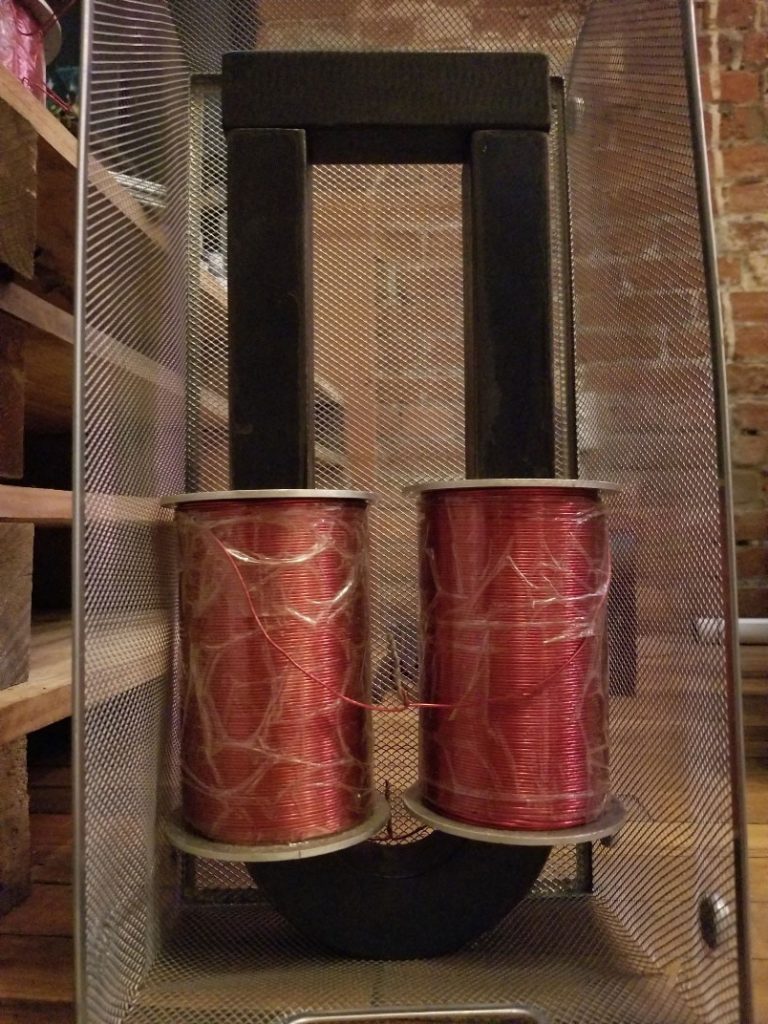
Museum grade replica of Ed Leedskalnin’s Perpetual Motion Holder built by RL Poole. For the author’s account of how to make it, see The Leedskalnin Codex.
So, we had the secret schematic over several sheets of paper, which details part of what Ed calls the Perpetual Motion Device. Alone, this made no sense. Then, almost a century later, we find that he hid a portion of it in plain sight all along that completes it. After that, we find this device mirrored in the guidelines he left us with, which are the first words of his book, Animal, Vegetable and Mineral Life. We then realise we must change the PMH from a magnetic device into an electrical device by adding the hidden part of the schematic. More remarkably, it becomes clear from Ed’s words about facing east that we’ve understood his teachings.
We know for sure that Ed meant for his booklets to be used as instruction guides, because in each booklet he included a blank page on which he wrote:
‘Reader, if for any reason you do not like the things I say in this little book, I left just as much space as I used so you can write your own opinion opposite it and see if you can do better.’
This is cryptic mastery at its finest. But in critically engaging with this mystery, we’ve raised more questions than answers.
Such is the nature of mysteries—the more we discover, the less we realise we know, and the less we realise we know, the humbler and more open we become.
But what is this Perpetual Motion Device for? And why did Ed go to such lengths to hide it from us? Let’s take a few steps back in time for clues, to revisit a civilisation celebrated by humble and open-minded thinkers for its cryptic dissemination of knowledge.
Feats of the ancients
He always called her ‘Sweet Sixteen’ whenever he mentioned her name,
Someday she would return to him when his labor of love gained fame!
He would build a show place for her then she would realize her mistake
She’d leave her simple peasant life and this Castle a home they’d make.
– Mary N. Yandell, The Mystery of Coral Castle.
By now, the minds of those among us familiar with the mystery schools are likely brimming with connections—between Ed’s teaching method, and that of the ancient Egyptians.
Let’s take a look at an example covered in Magical Egypt, a documentary series led by John Anthony West, whose perspective critically engages with the mystery of all that was left to us by the ancient Egyptians. To West et al., ancient Egypt it is ‘the land of secrets’ that yields evidence not of mankind’s earliest attempts at civilisation as the history books tell us, but of a developed and advanced culture whose scientific and metaphysical achievements we’re only just beginning to appreciate.xiv West et al. contend that Egyptology has missed the mark in understanding the knowledge left to us by the ancient Egyptians, due in large part to our misunderstanding their abilities and teaching methods. Curiously, I think the same about Coral Castle theorists.
In the first series of Magical Egypt, in an episode called ‘The Temple Of Man’, the narrator begins by asking:
‘The ancient temples of Egypt: simple monuments to the gods? Or complex puzzles that we are just beginning to understand?
…Recent discoveries are beginning to suggest that the temples were not just the location of the teaching… they were the teaching. An astonishing example is the Temple of Luxor. After recent revelations, some now call it the Temple Of Man.’xv
West explains that nineteenth century hermetic scholar Schwaller de Lubicz discovered a lost key, which decoded the language of this ancient temple—the key that ‘at long last enabled the temple to speak again’.xvi De Lubicz demonstrated the various rooms, walls and components of the temple each communicate a teaching of the aspects of living man that it corresponds to. In other words, the ancient Egyptians went to great lengths to encode their teachings in their monuments, because:
‘The temple was a complex, sacred teaching designed to be studied over time—it was a magical instrument intended to demonstrate and even facilitate the devoted student’s connection to a conscious universe. For those who could read the ancient language of the temple, it provided a map of the universe as reflected in humanity.’xvii
So, In Magical Egypt, West et al. demonstrate that the ancient Egyptian method of teaching was to leave its devoted students clues carved in reliefs and scripts and hide knowledge in its iconographical references and architecture.xviii In The Leedskalnin Codex, I demonstrate that Ed Leedskalnin used this very same method, by making his Coral Castle a monumental classroom designed to teach the devoted student like myself his knowledge on magnetism, physics, astronomy and rules of the universe.
I believe that in leaving the Coral Castle behind, Leedskalnin left us the keys to his kingdom, as the ancient Egyptians did.
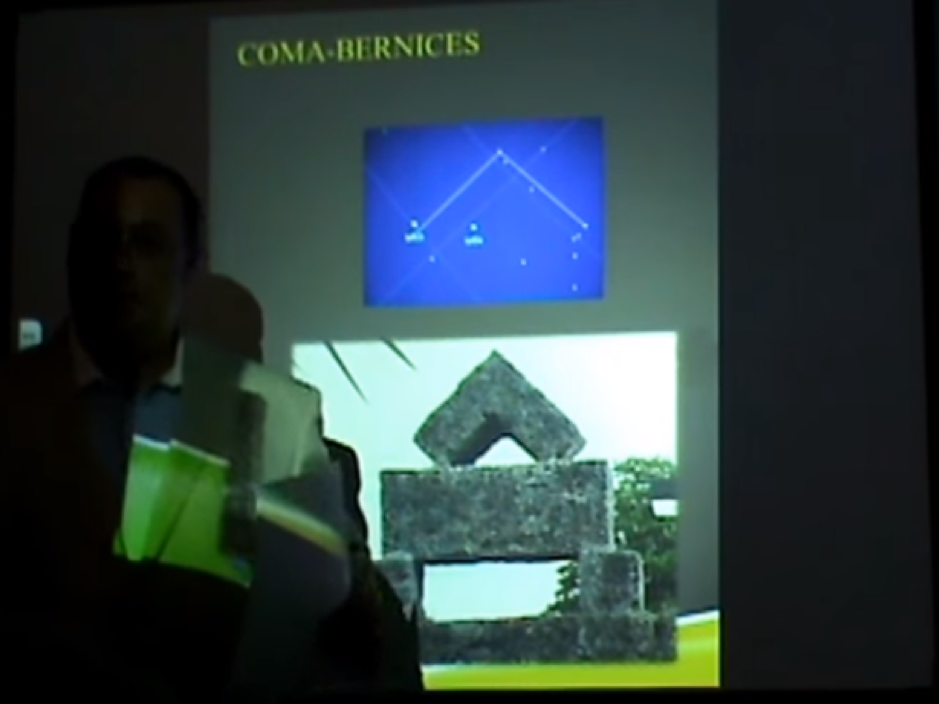
RL Poole showing the startling similarities between constellations, and the mysterious shapes carved into structures at the Coral Castle. This is the crown on the North Wall of the Coral Castle. Notice the unmistakable similarity with the constellation Coma-Bernices.
Ed’s Sweet Sixteen
Something we haven’t touched on yet is Ed’s obsession with who he refers to as his ‘Sweet Sixteen’—his long-lost love whom he claimed to have built the Coral Castle as an ode to. It’s for this reason that his castle is often referred to as Leedskalnin’s ‘Taj Mahal’. McClure and Heffron cover this aspect of Ed’s motivation for building the castle at length:
‘By the late twenties Ed was welcoming visitors to his ‘place’ on a regular basis. And by then he was beginning to formulate the speech he would give to those visitors while he gave them a tour of his unusual “home.” And at the center of that tour, from the very beginning, was the story about the girl he had left behind in Latvia. The girl who had left him at the altar. His Sweet Sixteen.
“That’s all he ever talked about,” says Charlotte Schmunk, who played at Ed’s place as a child in the 1930s. “He’d tell that story over and over.” She remembers that he often would look off into the distance as he talked about his lost love. “He didn’t seem to be of this world,” she says. “His mind was elsewhere.”
According to a number of local residents interviewed through the years, Ed would often look to the sky when speaking of her. As if picturing her in his mind.’xix
There aren’t any records of Ed ever contacting Agnes, his alleged ‘Sweet Sixteen’. Many who knew Ed have said they doubted she really existed.xx
In The Leedskalnin Codex I suggest that Ed ‘looked to the sky’ when speaking of his Sweet Sixteen, because his Sweet Sixteen was, in fact, up in the sky.
Indeed, the Coral Castle is an astronomical observatory designed to teach us Ed’s knowledge about his astrophysical theory, aka the ‘magnetic universe’—and at the crux of this theory is Ed’s Sweet Sixteen, which is carved onto the East Wall of his castle.
Once decoded, this ‘Sweet Sixteen’ is a celestial map or clock revealing not only a moment in time, but also a clue towards our decryption of Edward Leedksalnin’s wisdom trail—his understanding of precession is, as Robert Bauval pivotally demonstrated with regard to the pyramids on the Giza Plaeau, engraved on the Coral Castle in stone to act as a cosmological ‘mirror’ of his astrophysical understanding, as the ancient Egyptians and other ancient megalithic cultures did.xxi
Indeed, the sixteen alignments carved on the East Wall represent September 10th, 1923 at approximately 6:08 PM EDT. This was the date and time of a total solar eclipse; the day of a four-point syzygy, a rare alignment in which Venus, the Sun, the Moon, and the Earth are all in perfect alignment; the day of the Autumnal Equinox; and, of course, the year Ed built the Coral Castle.

The Coral Castle is an astronomical observatory designed to teach us Ed’s knowledge about his astrophysical theory, aka the ‘magnetic universe’—and at the crux of this theory is Ed’s ‘Sweet Sixteen’, which is carved onto the East Wall of the monument.
At this point the most perceptive among us will have spotted something: the above image of the East Wall displays just fifteen alignments. How can this be?
- Spica
- Saturn
- Virgo
- Leo
- Sun
- Moon
- Venus
- M104, The Sombrero Galaxy
- Cancer
- M44 The Beehive Galaxy
- Gemini
- Taurus
- Coma-Bernices
- Ecliptic equator
- Celestial equator
- Earth
Correct! Leedkslanin’s famous Sweet Sixteen isn’t a girl as relayed by McClure, Heffron and the rest of the history books. The Earth is the sixteenth celestial alignment in Leedskalnin’s Sweet Sixteen.
A final thought
We’re all familiar with the Great Pyramid mystery, so I won’t go into much depth on it here. Suffice it to say there is an obvious line of continuity between the mystery of how the Great Pyramid was built, and that of Ed Leedskalnin’s Coral Castle. It’s also notable that as recently as 2018, an article published in The Journal of Applied Physics found the Great Pyramid to be concentrating electromagnetic energy under its base and in its internal chambers.xxii
Unsurprisingly, Newsweek concluded in its coverage of the finding that:
‘The unusual electromagnetic properties of the pyramid are almost certainly just a coincidence of its structure, as it is highly unlikely that the Ancient Egyptians knew anything about this.’xxiii
…So the reluctance of mainstream thinkers to critically engage with mysteries continues.
I won’t waste words emphasising how backwards this line of reasoning is—best we move on knowing we’re a step ahead in appreciating this finding as potentially teaching us fascinating things about the ancient Egyptians and their abilities.
In the context of Ed Leedskalnin, his cryptic writing on electromagnetism, his obsession with astronomy and astrophysics, and his mysterious engineering abilities as evident in the Coral Castle, this scientific finding is especially intriguing. In fact, in the same year—2018—Gaia reports:
‘Adding to the mystery are the myriad remnants of an electromagnetic device in a chamber beneath the Coral Castle. There, one finds wires wrapped around bottles and odd devices with magnets and chains, appearing to resemble a generator of some sort. Next to the generator are two long metal poles reaching down beneath the ground, similar to the anode and cathode of a battery.
In the middle of the device is a flywheel made of concrete and magnets and shaped like a four-leaf clover. Many believe this was a perpetual motion device, based on claims from Leedskalnin’s pamphlet Magnetic Currents. When one holds a compass to the device and cranks it, the compass needle spins, indicating the magnets are set opposite in polarity.’xxiv
These thoughts are really just a spit of sand in our building of a Coral Castle theory that does the work of Edward Leedskalnin justice. I hope this article, and my book that it’s based on, convince you to give Ed’s ideas a chance—who knows whose wisdom he might be trying to teach us…
References
i Historians from Latvia provide different name and age for Ed’s fiancé—Hermīne Lūse, two years younger than Ed. Māris Goldmanis, Researcher at University of Latvia. Edward Leedskalnin and his Coral Castle in Florida, Latvian History, January 11, 2014.
ii Heffron, Jack. Coral Castle: The Mystery of Ed Leedskalnin and His American Stonehenge. Ternary Publishing. Kindle Edition. 1116
iii ibid.
iv Radford, Benjamin. ‘Mystery of the Coral Castle Explained,’ Live Science (1 June 2018).
v ibid.
vi Heffron, Jack. Coral Castle: The Mystery of Ed Leedskalnin and His American Stonehenge.
vii Irwin, Orval. Mr Can’t Is Dead: The Story of the Coral Castle (Plastic Comb, 1996).
viii Heffron, Jack. Coral Castle: The Mystery of Ed Leedskalnin and His American Stonehenge.
ix ibid.
x ibid.
xi ibid.
xii ibid.
xiii ibid.
xiv Magical Egypt (Streamed here: http://www.magicalegypt.com)
xv Magical Egypt, Episode 4: The Temple Of Man (Streamed here: http://www.magicalegypt.com/)
xvi ibid.
xvii ibid.
xviii ibid.
xix Heffron, Jack. Coral Castle: The Mystery of Ed Leedskalnin and His American Stonehenge.
xx Heffron, Jack. Coral Castle: The Mystery of Ed Leedskalnin and His American Stonehenge.
xxi See Bauval, Robert & Gilbert, Adrian. The Orion Mystery: Unlocking the Secrets of the Pyramids (Broadway Books, 1995). Also see Hancock, Graham & Faiia, Santha: Heaven’s Mirror: Quest for the Lost Civilisation (Three Rivers Press, 1999).
xxii Balezin, Mikhail et al. ‘Electromagnetic properties of the Great Pyramid: First multipole resonances and energy concentration’ in Journal of Applied Physics (124, 2018).
xxiii Georgiou, Aristos. ‘Ancient Egypt: Incredible Electromagnetic Discovery in Great Pyramid of Giza’s Hidden Chambers’ (Newsweek, 31 July 2018).
xxiv Gaia Staff. ‘Who Was The Mysterious Ed Leedskalnin, Creator of the Coral Castle?’ (16 August 2018).








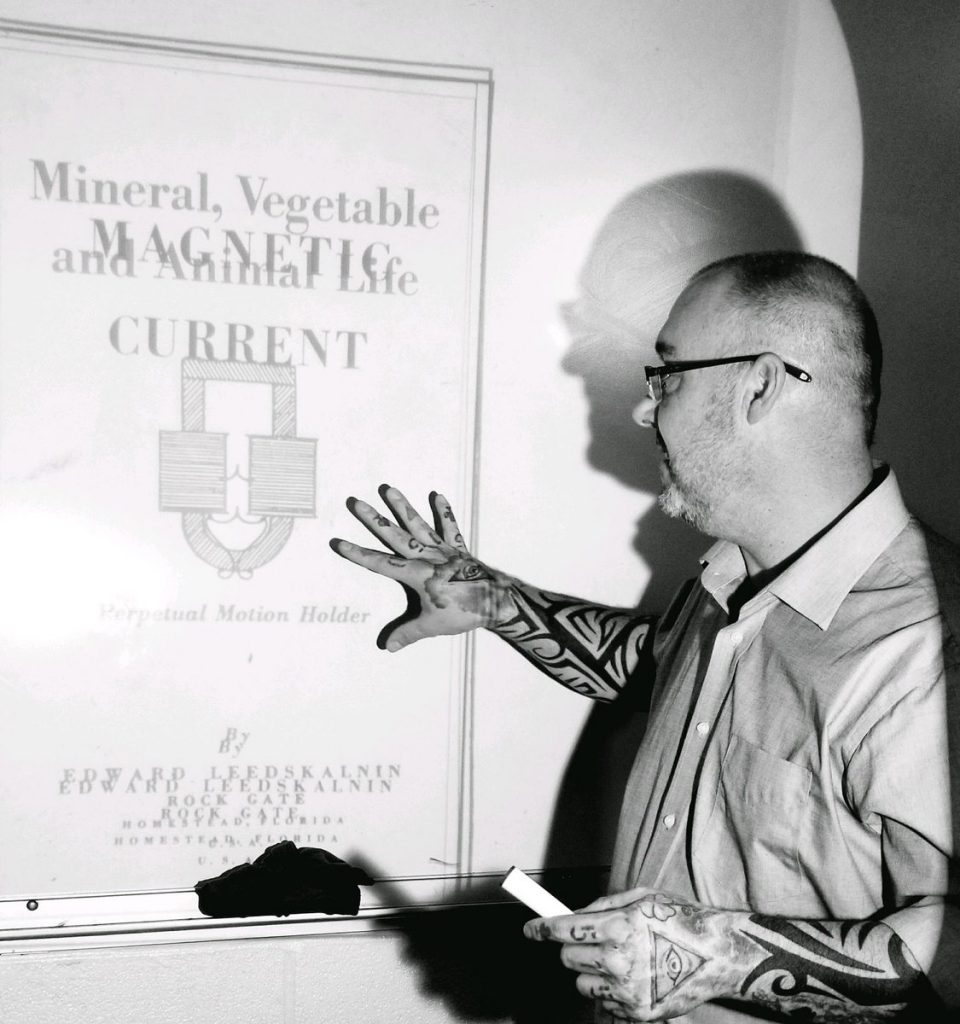
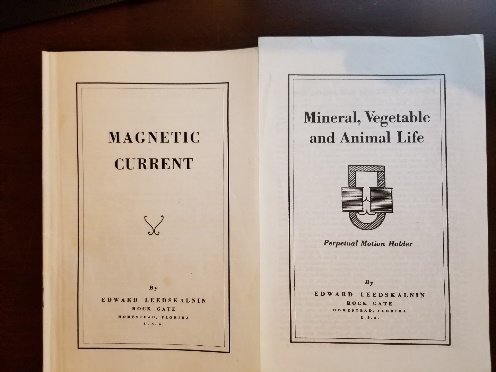

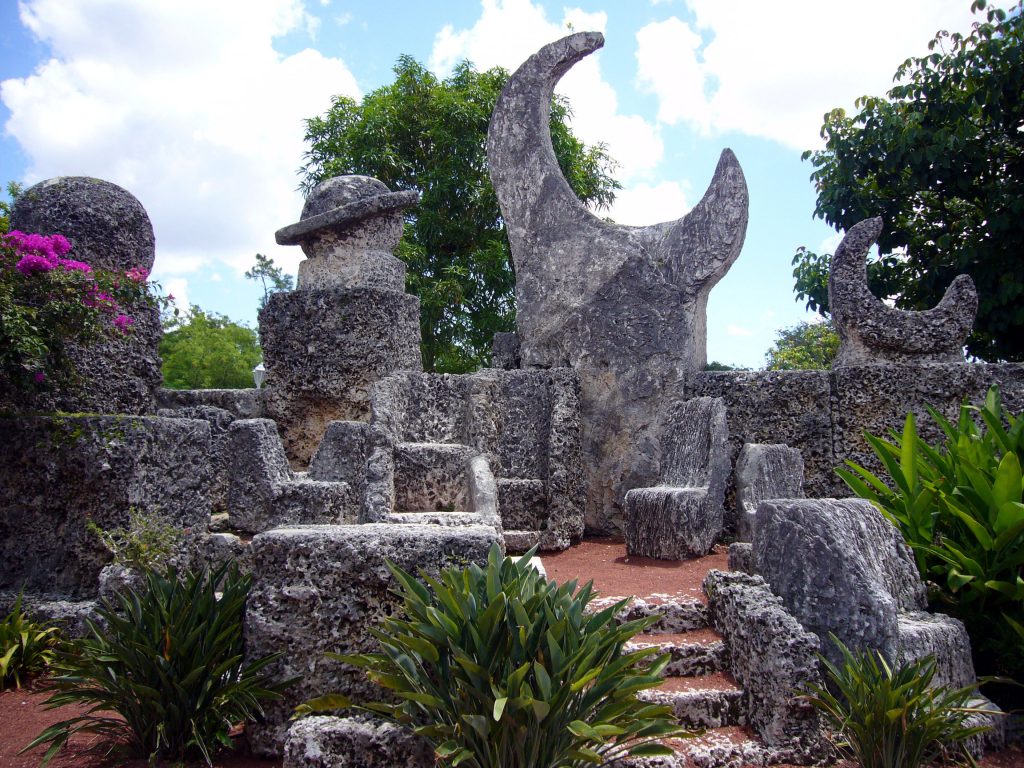
Mr. Poole: Liked your article. Curious t’ought popped into me head just now, since you were talking about astronomical alignments: Is there an aerial view or ‘map’ of the whole Coral Castle? Could there also be encoded some astronomical/astrophysical data or other schematic encoded into the alignments of the total structure? It looks very complex on Google Earth & no obvious pattern sticks out, but dat doesn’t mean there is one. Good luck with your book. You already have some from Graham choosing your book for the month. Graham’s a great guy.
Hi Seamus,thank you for your questions and comments. There is indeed an aerial view available of the Coral Castle, and i believe that it is provided by the Coral Castle museum itself among the flyers and literature available there for tourists. I have noticed some indications which point to the possibility that there could be a code hidden in this view of the castle, and that is clever thinking on your part. And, like you, I have nothing to corroborate that idea, lol so I have tabled it until something falls into place. Thank you so much for wishing me luck with my book, and you are so so right about the great fortune of my work being recognized by Graham, and then being provided a platform to reach those who study his work as well. I am not only an avid admirer of Graham’s writing and speaking, but of his character and humanity. I am honored, humbled, and inspired to have my work found to be of this level of significance, by a writer and intellectual of Graham’s caliber. Have a great day, and thanks for taking the time to share your thoughts with me. Be well!
Here’s my take: https://youtu.be/_JD10jouSlQ
Thank you for your take.
I have a hunch that the ideology of Eric Dollard regarding the component ingredients of electricity are integratable with the component ingredients of electricity according to Edward Leedskalnin which I attempt to describe in this video of my talking head…
https://youtu.be/jN2TyUaTQFA
Thank you for your comment!
Found the explanation on YouTube explaining Ed’s techniques in the building of Coral Castle. What do you think?
https://youtu.be/nOoCuDnmtyM
I think its ridiculous in its premise, and null in its results. Unfortunately, people will reach for the prosaic no matter how little evidence actually supports it. This person should be able to replicate Ed’s feats easily, yet has not been able to quarry and lift a single stone the size that Ed did using the same techniques.
“I am not only an avid admirer of Graham’s writing and speaking, but of his character and humanity.”
Exactly, Mr. Poole. And also, Graham Hancock is a person of very great courage.
Thank you for this interesting article.
One question I have always had is, even granting that Leedskalnin was probably of a very high intelligence, did he originally obtain his knowledge from elsewhere? Do you think this early lover of reading might have gained some of his insights into magnetic current in his homeland? Or, possibly even in the Pacific Northwest, as strange as that may sound?
Thank you so much for your message, and your question. I believe that Ed possibly had a type of autism like mine, which creates the ability of extremely high function in certain areas, and in his readings came across a connection which he followed to its conclusion, re-discovering an ancient type of science. And, I believe that he had at least a partial idea of that science before he emigrated to America, based on the location he chose to build the Coral Castle. I think that was the plan from the beginning. These are all conjecture, so take them for what you will.
Hi Mr. Poole,
What I found interesting is that, when September 10, 1923; 6:08PM; and Homestead, FL are added to a natal/event chart generator, a kite pattern appears. A kite pattern, in astrology, begins with a grand trine, which is 3 planets in a triangle-style pattern, within accepted degrees, in three different zodiac signs of the same element (each planet roughly 120 degrees apart); in this case in water signs: Uranus in Pisces (and conjunct the ascendant), Pluto in Cancer, and Jupiter in Scorpio. Next, there has to be 2 sextiles on one side of the trine (sextiles are 60 degrees apart); in this case, Jupiter sextiles the stellium (roughly 3 or more planetrs conjunct) of Sun, Moon, and Venus in Virgo, and that stellium sextiles Pluto. Lastly, there must be an opposition on the opposite side of the universe (opposite the sextiles), which occurs here with Uranus opposed the stellium in Virgo. This configurations are, of course, rare. This has to be EXACTLY what Ed Leedskalnin anticipated and recorded, choosing the date, time, and locations, specifically. The one thing that puzzles me is the fact that Pluto was not “officially” discovered until 1930, so how could he have known? What evidence or artifact did Leedskalnin have that provided an ability to anticipate celestial positions?
Well, we have to remember that this was an ongoing build for Ed, so it is possible he learned of Pluto later, and then added it to his celestial alignment once he learned of its orbit, and could calculate its position that day. In other words, he could have retroactively added it, once that information was confirmed. Good comments!
Thank you for reminding me of this modern enigmatic building. I tested the site plan to see if, or how, Leedskalnin incorporated a star map, but confirmed only two or three of the eastern wall skyline constellation outlines. Very few built sites in any era include star maps. The Einstein monument in Washington is one of the very few exceptions. However the full cosmological structure is present, as usual, but in archetypal form, via subconscious expression, as in all built sites. I used an aerial photo, since the site plan sketches are inaccurate, as usual at tourism sites. See my post here;
https://stoneprintjournal.wordpress.com/2020/03/11/leedskalnins-rock-gate-or-coral-castle-is-a-domestic-energy-vortex/
Hello, I explain, and show in detail in my article, as well as my book the constellations and their representation on the wall, in their shape, and proportion, as well as the order. Also, not all of the celestial components are present on the wall. The Moon Fountain is actually M104 the Sombrero Galaxy, found directly under Virgo, and on the wall where Cancer is represented there is another 6 pointed star which is in the exact spot to represent M44 or the Beehive Galaxy. I will put my knowledge of astronomy as it relates to the Coral Castle up against anyone else’s since, not to be insulting, I am the one who discovered it to begin with. To say that you only confirmed two or three of the constellations I discovered represented on the wall is like saying you can only confirm that I found 2 or 3 Pharaohs no one had ever seen before…Im beginning to wonder what a person has to do to impress another in this jaded world, anymore. I would think that finding any provable astronomical ties to the Coral Castle should be headline news, not something to be minimized, and then shrugged at. Also, Im not sure how you tested it, what your qualifications are to do so, and you certainly didn’t consult with the discoverer about the information, so it’s quite possible that number would go up considerably if it were conducted scientifically. Thank you for your message.
The builder’s programme was partly astronomical, particularly involving planetary positions in the 1923 eclipse, as you discovered. But also partly astrological (Saturn was in constellation Libra, but in sign Virgo, since the two grids are about 30 degrees apart). And mainly intuitive, as I demonstrate in text and images. These three motivations should be separated when studying site features. The monument’s astronomical features are partial and mixed with astrology. The astrology is partial. The intuitive context is complete, as usual, see my article via the link above, where I praise your discovery.
I could find no astronomical or astrological reason for the large Moon Fountain to express the Sombrero Galaxy south of Virgo. Nor for the six-pointed star in the Cancer area to express the Beehive Galaxy. I am impressed by your discovery of the relevance of the 1923 eclipse to this monument.
The builder’s programme was partly astronomical, particularly involving planetary positions in the 1923 eclipse, as you discovered. But also partly astrological (Saturn was in constellation Libra, but in sign Virgo, since the two grids are about 30 degrees apart). And mainly intuitive cosmological alchemy, as I demonstrate in text and images. These three motivations should be separated when studying site features. The monument’s astronomical features are partial, and mixed with astrology. The astrology is partial. Taking account of both grids, could raise the accuracy of your reconstruction of part of the consciously intended programme. The subconscious expression or intuitive context is complete, as usual, see my article via the link above, where I praise your discovery.
I could find no astronomical or astrological reason for the large Moon Fountain to express the Sombrero Galaxy south of Virgo. Nor for the six-pointed star in the Cancer area to express the Beehive Galaxy. I am impressed by your discovery of the relevance of the 1923 eclipse to this monument.
The problem with the correspondence theory approach to archaeo astronomy, is that it limits itself to the conscious ‘sky map’ paradigm. If the builder intended a sky map, he could have built one. He built more than that, as I demonstrate in notes on each feature, and on the polar features.
Wow just read the above comments and can’t quite believe how civil and pleasant they all are. This article took me way back to my younger day when I found a stack of old Nexus magazines in a cabin on a Nimbin commune and spent months and months discovering things like the Coral Castle. Congratulations guys on showing what a comments section should be like
Isn’t that reading time an amazing investment in ourselves, which pays dividends down the road? Glad you dropped by, and saw this.
I saw a blurb about a woman who ran for office in florida. she said when she was young, some aliens picked her up for a joyride. They also told her some things about the planet, and one of them was “that place you guys call coral castle, did you know theres a pyramid underneath it?”
si perhaps with a ground penetrating radar….
That is a question which is out of my depth. I have no idea about this story, or its validity, but thank you for sharing it with me.
this is absolutely awesome! Mr. Poole, your mind is a gift!
That’s very kind of you, and much appreciated. I am glad to see others be as excited about this information as I am. It really should be getting more attention than it has, but I have learned it is not the quantity of people who foster success, but the quality of the individuals who are interested in your information which will grant discoveries like these their day in the Sun. I am so grateful, and humbled that Graham Hancock chose me as his AoM. It is very validating that a man of his obvious intellect sees the value in my work, and wishes to share it with his readers, and followers. Because of people like Graham, research like mine can be given a voice.
Good evening. Just finished reading your book. Have you had any success in working with figuring out how to use the PMH that you built? Will the results perhaps be another book?
Hello and thank you for reading my book. While the PMH is going to be the subject of at least one book I am writing I have had another breakthrough in cracking one of Leedskalnin’s codes that everyone has tried, and none have succeeded. But, I did it. ANd, anyone who buys my second book will be very glad that they bought the first one and read it, so good for you! The PMH has yielded some results for me, which I am not comfortable revealing at this time. It is power, and you have to be careful when you give people power. Im thinking it through. Thanks so much for your questions, and for being a reader of my work, and for taking the time to interface with me about it! Stay tuned!
Mr. Poole, thank you for your hard work and dedication. Sharing it with us is truly a gift, as cdh said above. This information and knowledge is a gift most of us, like myself, can not fully understand or appreciate… I feel like I run into a wall or perhaps into cloud when I try to approach it.
Nonetheless, I do have a very straightforward question: are you familiar with Emery Blagdon and his Healing Machine? Looking at the perpetual motion holder, I immediately thought of Mr. Blagdon.
Thank you again.
Thank you so much. I was not aware of Mr. Blagdon, but he certainly had a beautiful idea, didn’t he? Very shamanistic, I think. I believe that you can indeed understand these concepts. Magnetism is the perpetual motion engine of the Universe, and is the source of our future energy. Mr. Leedskalnin proved this through these accomplishments, and his own observations, that he had mastered the physical force of magnetism. This is the secret hidden in the building of other, ancient megalithic sites, I believe. The magnetic celestial alignment he shows the year he started building the Coral Castle explains why astronomy was so important to ancient megalithic cultures. Every notice that the cultures who were obsessed with the stars were also master megalithic building cultures? One allowed the other to happen. Their structures could only be as good as their astronomy, so they made their astronomy as perfect as possible. And their accomplishments seem to directly correlate to exactly that. What they were learning through that mastery of astronomy, was the careful observation of magnetic spheres interacting in predictable, and systematic fashion, which creates a temporary means by which to defy the currently misunderstood laws of physics, if you know what to do during that time period. I think this honestly explains their obsession with the stars, and how they built megalithic structures, because they understood everything came from the same force. The force of magnetism. Thank you for your kind comments, and for your question!
Keep thinking!